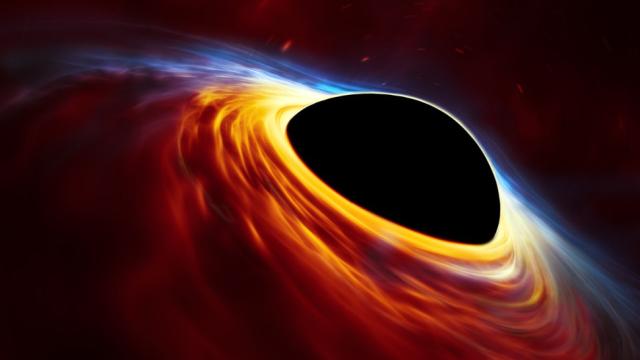Last year, astronomers recorded the brightest supernova explosion ever seen. Follow up observations now suggest this cataclysmic event wasn’t a supernova at all, but rather, an extremely rare celestial phenomenon involving a supermassive black hole and a rather unfortunate star.
Artist’s impression of a rapidly spinning supermassive black hole surrounded by an accretion disc — one consisting of the shredded remains of a Sun-like star. (Image: ESO, ESA/Hubble, M. Kornmesser)
In 2015, astronomers participating in the the All Sky Automated Survey for SuperNovae (ASAS-SN) witnessed what they thought was an unusually bright supernova. Dubbed ASASSN-15lh, it was twice as bright as the previous record holder, shining 20 times brighter than the total light output of the entire Milky Way galaxy. A supernova is the brilliant, dying gasp of a large star that can no longer balance the tremendous forces keeping it together, producing a shockwave that blows the star’s outer shell into space with tremendous force.
A new follow-up study published in the journal Nature Astronomy casts doubt on this initial assessment, proposing that ASASSN-15lh isn’t a superluminous supernova at all, but instead the consequence of a Sun-like star that ventured too close to a rapidly spinning supermassive black hole — an exceptionally rare cosmological event known as a tidal disruption.

Artist’s impression of the Sun-like star as it careens towards the supermassive black hole. (Image: ESO, ESA/Hubble, M. Kornmesser)
“We observed the source for 10 months following the event and have concluded that the explanation is unlikely to lie with an extraordinarily bright supernova,” noted lead investigator Giorgos Leloudas, an astronomer at Israel’s Weizmann Institute of Science, in a statement. “Our results indicate that the event was probably caused by a rapidly spinning supermassive black hole as it destroyed a low-mass star.”
During a tidal disruption, the extreme gravitational forces of a supermassive black hole “spaghettifies” and rips apart a star when it wanders too close. The shocks produced by the colliding debris, along with the tremendous amount of heat generated, produces an incredibly brilliant burst of light. This particular event transpired in a galaxy four billion light years from Earth, and it’s only the 10th tidal disruption ever recorded.
Above: An animation showing how the ASASSN-15lh most likely happened.
During the 10 months that followed the outburst, the astronomers watched as ASASSN-15lh went through a series of phases consistent with a tidal disruption. The object lit up in ultraviolet light and experienced a temperature increase — features that are not consistent with a supernova event. What’s more, the location of the outburst in a red, massive and passive galaxy is not the usual home for a superluminous supernova explosion, which typically happens in blue, star-forming dwarf galaxies.
The researchers based these conclusions on observations made from the Very Large Telescope at ESO’s Paranal Observatory, the New Technology Telescope at ESO’s La Silla Observatory, and the Hubble Space Telescope.
Above: This simulation shows a star getting torn apart by the gravitational tides of a supermassive black hole. The star gets “spaghettified”, and after several orbits creates an accretion disc. The view on the right is from the side, and at left from face on. (Credit: ESO, ESA/Hubble, N. Stone, K. Hayasaki)
That said, this particular tidal disruption — if that’s what it really is — is quite unique, requiring a special set of circumstances to make it happen.
“The tidal disruption event we propose cannot be explained with a non-spinning supermassive black hole,” explained Nicholas Stone from Columbia University. “We argue that ASASSN-15lh was a tidal disruption event arising from a very particular kind of black hole.”
The supermassive black hole at the core of this galaxy features a mass about 100 million times that of our Sun. Normally, a black hole of this size wouldn’t be able to disrupt stars outside of its event horizon — that fateful boundary within which nothing is able to escape. But if this black hole happens to be a so-called Kerr black hole — a black hole that features a rapid spin — this limit no longer applies, and the black hole is able to suck up any star that ventures within a certain radius.
The researchers aren’t fully confident that the outburst came from a tidal disruption, but the clues certainly fit that scenario. Further observations will be needed to make a definitive case.
